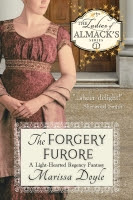How talented are you?
That’s a question young ladies of good family had to consider when they
were about to make their debuts in nineteenth century England. The ability to make good conversation, play
an instrument, acquit herself well on horseback, and perhaps manage a household
were supposedly prized traits for gentlemen looking to acquire a wife. But there was another more important
practical skill, for ladies of any social strata: the ability to sew a fine hand.
Though wealthier ladies were more likely to have someone
else like a maid or seamstress mend their clothes (or throw damaged items away
entirely in the most spendthrift households), a wife who could reattach a
button, hem up a skirt, or take portions of outfits and repurpose them was
generally to be commended. Then too,
many a young lady fell to embroidering seat covers, nightgowns, and other items
she would need for her trousseau. Even
older ladies were known to embroider to pass the time.
The basic stiches, such as the chain stitch, blanket stitch,
satin stitch, and cross stitch were the same then as we know today. The thread might be fine silk or warm wool. Designers sold patterns, but some ladies made
up their own. And some of the
workmanship was exquisite, as in this apron made from silk.
According to the Victoria and Albert Museum, which has a
wonderful online display about embroidery, the designer William Morris played a large role in making English embroidery even
more popular in the mid-1800s. That's one of his designs at the right. His
patronage led to the establishment of the Royal School of Art Needlework, which
produced and sold embroidery and designs as well as trained students.
Me? Well, I have
embroidered a few pillow cases and table runners in my time, but I would certainly
not rank stitching among my accomplishments.
What about you?








8 comments:
Regina, both Ackermann's and La Belle Assemblee as well as the French publication Modes de Paris frequently published needlework designs--I'll look to see if I have any.
Ooo, cool! Definitely share if you find some. Thanks!
I learnt how to embroider at school (when I was about 8) and made a few things as Christmas gifts (very simple) and haven't done any for years. I certainly couldn't do this type of beautiful fine work.
I like the way clothes were rarely truly thrown away in those days. They were one of the perquisites of the lady's maid, and if she didn't want to alter them to fit her she could trade or sell them at shops which existed purely to deal in second-hand clothes. And many people could only afford to buy their clothes at such shops, so they had a new life before being traded back or sold to a dealer in more worn clothes. And so on down the line; only the most irreparable garments ended up being used to make paper and at each stage of their life they provided a living for someone, including scavengers. True recycling in action!
Very true, Helena. We think "recycling" is something invented recently, but Regency and Victorian England made an art of it! And I must say I have a few pieces I can no longer wear that I love so much I'm hoping a granddaughter or daughter-in-law will come along some day and want them.
I did quite a bit of needle art as a child and teen. I often drafted my own patterns, the most elaborate being an Elizabethan blackwork piece similar in motif to the first sample in your post, but much coarser. I wish I had the time to do it today, but the last three projects I started rusted on the hoop. I also crocheted lace doilies, tatted, even tried bobbin lace!
I have just discovered this blog and am slowly catching up on back posts. I have been a fan of regency novels for 40 years, read them as a teen, never really thinking of them as YA novels, nor that the protagonist was often a "teen". It is an interesting way of looking at it. I shall try to locate one of your novels to see your take on the subject.
Welcome Chemystress! How cool that you could master all those arts! I've always wanted to try tatting. Maybe someday. Enjoy the back posts, and hope to hear from you in the future.
I'd fail miserable as a Regency heroine. I'm a bluestocking. The only accomplishments I have are research/reading and baking. I talked to one mother in the year 1800 (actress interpreting a real woman) who had one daughter who was educated in math and science. She was an amateur astronomer. The mother lamented the fact that her girls didn't know how to do housework and only one could bake a cake. They probably were good at needlework, singing, playing music and drawing too. Only one of the three married a wealthy man so I don't know how useful those accomplishments ended up being!
You know, QNPoohBear, accomplishments or not, it's all in meeting the right man! My husband says his number one criteria in a wife is intelligence. A smart wife means smart kids. I would think at least a few gentlemen in the Regency understood that too! Hm--I feel a story idea coming on!
Post a Comment